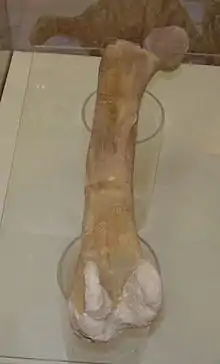Peruc–Korycany Formation
The Peruc–Korycany Formation is a geologic unit of Upper Cretaceous age, located mostly in the Czech Republic. It is the oldest unit of the Bohemian Cretaceous Basin, which overlies Silurian-aged metamorphosed rocks of the Bohemian Massif. It consists of fluvial to shallow marine sediments.[1]
| Peruc–Korycany Formation | |
|---|---|
| Stratigraphic range: | |
| Type | Geological formation |
| Sub-units | Peruc Member, Korycany Member |
| Underlies | Bila Hora Formation |
| Overlies | Metamorphic basement |
| Lithology | |
| Primary | Sandstone, Mudstone, Conglomerate |
| Location | |
| Country | Czech Republic |
| Extent | Bohemian Cretaceous Basin |

Burianosaurus femur, found in 2003 near Mezholezy.
Paleontology
Dinosaur fossil remains about 94 million years old (Cenomanian stage) were found in 2003 near the village Mezholezy (Miskovice), by Kutná Hora. This small basal ornithopod dinosaur was officially named Burianosaurus augustai in 2017.[2]
References
- Caracciolo, Luca; Le Pera, Emilia; Muto, Francesco; Perri, Francesco (10 August 2011). "Sandstone petrology and mudstone geochemistry of the Peruc–Korycany Formation (Bohemian Cretaceous Basin, Czech Republic)". International Geology Review. 53 (9): 1003–1031. doi:10.1080/00206810903429011. ISSN 0020-6814.
- Madzia, Daniel; Boyd, Clint A.; Mazuch, Martin (2017). A basal ornithopod dinosaur from the Cenomanian of the Czech Republic. Journal of Systematic Palaeontology: 1–13. doi:10.1080/14772019.2017.1371258
This article is issued from Wikipedia. The text is licensed under Creative Commons - Attribution - Sharealike. Additional terms may apply for the media files.